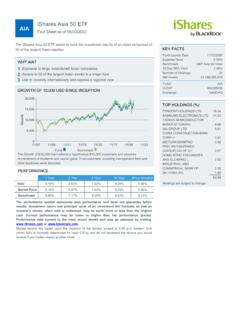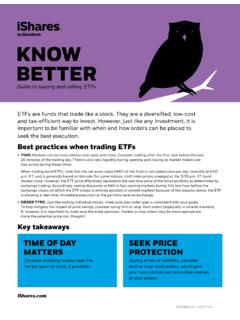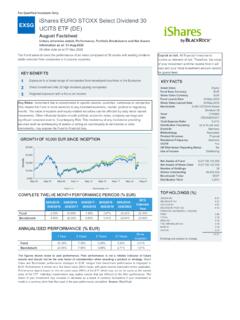Transcription of The next generation bond market - BlackRock
1 The next generation bond market FOR INSTITUTIONAL USE ONLY - NOT FOR PUBLIC DISTRIBUTION. ICR0917U-255379-805339. How changes in market structure, liquidity & products are shaping tomorrow's bond markets Fixed income markets have undergone significant structural change since the 2008 financial crisis. These seismic shifts are forcing investors to adapt to a new market paradigm that will challenge not only how they trade fixed income, but what types of products they use to build bond portfolios and manage risk. In this paper, we examine the evolution of the bond market through three interconnected lenses: the liquidity environment, market structure and product preferences. All three are changing in the post-crisis era with implications for the shape of the future bond market and investors. Similar to what took place in equities, we believe the coming years will be marked by a major transformation in fixed income.
2 In this new world, investors may have to think differently about how to build portfolios, how to trade and what to trade. ICR0917U-255379-805339. Table of contents 04. Executive summary 06 07 17. The pre-crisis The post-crisis The next generation bond market bond market bond market 18 19. Conclusion Appendix ICR0917U-255379-805339. Executive summary Investors must now think differently about how to navigate fixed income markets: from trading in a new market structure, to re-assessing liquidity, to determining which products will best deliver a desired outcome. The rise of a modern, networked bond market The traditional principal-based fixed income market is transforming into a hybrid principal/agency market . Driving this change are the entrance of new market participants and the emergence of all-to-all trading technologies that offer an alternative means to trade bonds: from bilateral and voice-driven to multi-dimensional and electronic.
3 The transition to a hybrid model is a challenge for investors, but may result in a more connected, diverse and modern bond market with more trading participants. Liquidity needs to be reexamined Challenges post-crisis have forced traditional bond dealers to fundamentally rethink their business models. Broker dealer inventories have fallen, although the magnitude of the decline may be debated. At the same time, however, the size of the investment grade corporate bond market has tripled over the past decade to ~$ trillion in debt Inventories have recovered somewhat recently, but relying solely on the old model will likely not suffice. Investors need to think about how best to access liquidity across products and asset classes, using a broader, more robust suite of liquidity measures and exposure vehicles. Not all investors have the same liquidity needs and the degree of liquidity required in part dictates the type of instrument employed for portfolio construction.
4 1. Source: Bloomberg, Barclays, as of 6/30/17. 4 THE N EX T GE N E R AT ION B ON D M A R K E T. ICR0917U-255379-805339. Index-based products central to portfolio construction and risk management Today, the changing market structure means that building fixed income portfolios solely with individual securities can be increasingly costly and less efficient than in the past, leading investors to employ a range of instruments. Post-crisis, demand for transparent, standardized and bundled exposures has manifested in growth among index-based products like credit default index swaps (CDX), total return swaps (TRS) and bond exchange traded funds (ETFs). These products are fulfilling investor needs for building blocks to construct portfolios and manage risk more efficiently. bond ETFs in particular have proven to be a valuable solution in meeting these needs. In the last five years, assets have grown 25% per year while trading volume has more than doubled.
5 bond ETFs are on pace to be a $ trillion market by The trend towards a networked bond market is likely to accelerate and be more disruptive than many market participants currently expect. We believe that those who embrace and adapt to the coming changes have the potential to benefit most. Authors Richie Prager Daniel Veiner Head of Trading, Global Head of Liquidity and Investments Platform Fixed Income Trading Brett Pybus Stephen Laipply Head of EMEA iShares Head of iShares Fixed Income Strategy Fixed Income Strategy Vasiliki Pachatouridi Hui Sien Koay iShares Fixed Income Strategist iShares Fixed Income Strategist 2. Based on the global AUM of $741 billion and a 20% compound annual growth rate, as of 8/31/17. 5. BL AC K RO CK ICR0917U-255379-805339. The pre-crisis bond market Over-the-counter and opaque Liquidity Electronic RFQ platforms were just taking root, serving Prior to the 2008/2009 financial crisis, broker-dealers predominantly more liquid products such as enjoyed a relatively low cost of balance-sheet funding and Treasuries, Agencies and Agency MBS.
6 Even with the capital, enabling them to warehouse risk for extended advent of reporting systems like the Trade Reporting and periods of time. As a result, dealers were willing to Compliance Engine (TRACE), transparency generally make markets in significant size in both cash bonds and remained challenged. associated derivatives. Volumes were generally robust Products and liquidity was perceived as relatively deep across most In addition to traditional cash bonds, investors traded a asset classes. variety of derivative instruments across interest rates and As Figure 1 illustrates, as a largely principal trading credit. Interest rate futures, swaps and options markets market , the concept of liquidity was highly correlated with were generally robust. In credit, the immediate pre-crisis the inherent riskiness of an asset class. As an example, period saw investors able to source or hedge exposure Treasuries were perceived to have a low degree of to individual companies through bespoke single name idiosyncratic risk and therefore considered highly liquid credit default swaps (CDS).
7 Over time, standards and relative to speculative grade corporate bonds, which were documentation for CDS became harmonized across perceived to have a high degree of idiosyncratic risk. dealers. Counterparty exposure, however, was still Liquidity was often represented by the one dimensional managed through bespoke, bilateral collateral posting metric of bid/ask spread, which tended to reasonably arrangements between dealers and individual clients. capture a dealer's risk appetite and ability to either hedge While the move towards standardization in CDS helped or offload risk. facilitate growth in the CDX index contract, many other market structure derivative exposures were often bespoke, complex bond trading was conducted almost exclusively in structures that frequently employed significant degrees decentralized, over-the-counter (OTC) markets, where of leverage. investors negotiated directly with broker-dealers.
8 Trading was bilateral and voice driven. Figure 1: Pre-crisis liquidity framework Asset liquidity dependent on perceived riskiness High Investment Government yield grade More risk and less liquid Less risk and more liquid For illustrative purposes only. 6 THE N EX T GE N E R AT ION B ON D M A R K E T. ICR0917U-255379-805339. The post-crisis bond market Regulation and reorganization The global regulatory reforms enacted in the wake of Fixed income trading, traditionally reliant on bank or the financial crisis have catalyzed change in fixed income broker-dealer balance sheets, has been especially markets. Notwithstanding the current debate around the impacted. Higher funding and capital costs have resulted appropriate size and scope of post-crisis regulation, the in a reduction in traditional risk warehousing, given effects have been profound, impacting liquidity, market challenges in attaining ROE targets.
9 market liquidity structure and fixed income product availability. has also been impacted by a retrenchment in the repo financing market for individual bonds. Liquidity The onset of the crisis resulted in a sharp and immediate As a result, cash bond trading has migrated to more of a reduction in balance sheet and market liquidity as many hybrid principal/agency model. Agency trading, in which broker-dealers and other market participants struggled buyers and sellers are located and matched by banks with funding and capital adequacy challenges. and broker-dealers, has played a more prominent role as opposed to facilitating trades more through principal While liquidity recovered somewhat in the immediate risk taking. aftermath of the crisis, the introduction of post-crisis regulation (Figure 2) among other things has resulted in higher funding and capital costs for banks and regulated broker-dealers. 7.
10 BL AC K RO CK ICR0917U-255379-805339. Figure 2: Global regulatory and legislative development overview Seismic regulatory shifts affecting all market participants Legislation Region Summary Effective date Dodd-Frank Wall An unprecedented rulemaking process, ongoing for more Varies Street Reform than eight years with nearly 400 new regulations involving and Consumer at least a dozen regulatory agencies. Protection Act Volcker Rule Part of Dodd-Frank, generally prohibits banking entities April 1, 2014. from engaging in short-term (non market -making related). trading of securities, derivatives, commodity futures and options on these instruments for their own account. In addition, banks are not permitted to own, sponsor, or have certain relationships with hedge funds or private equity funds. Basel III Global In December 2010, the Basel Committee on Banking January 1, 2019. Supervision (BCBS) agreed to new rules outlining global regulatory standards on bank capital adequacy and liquidity.



















